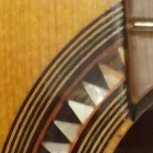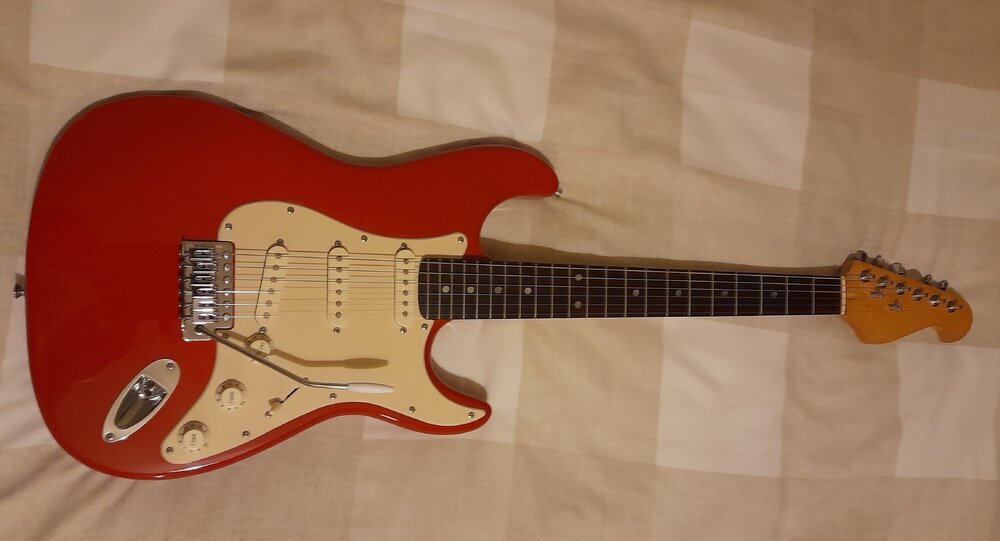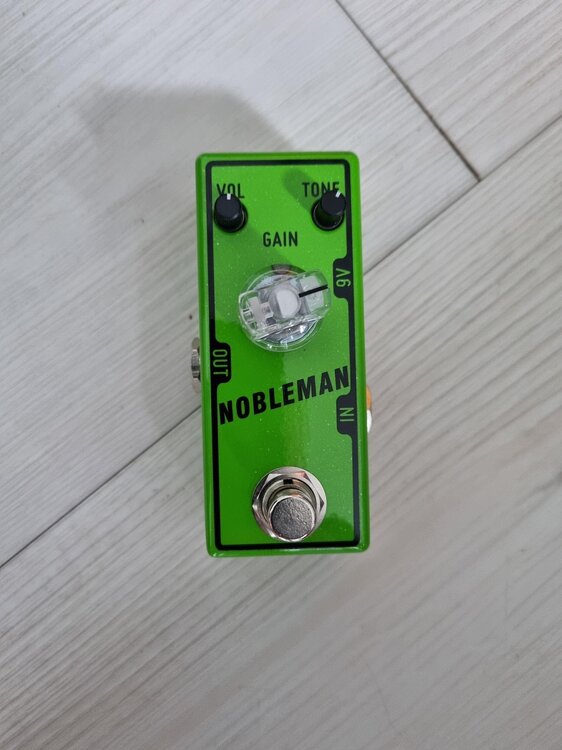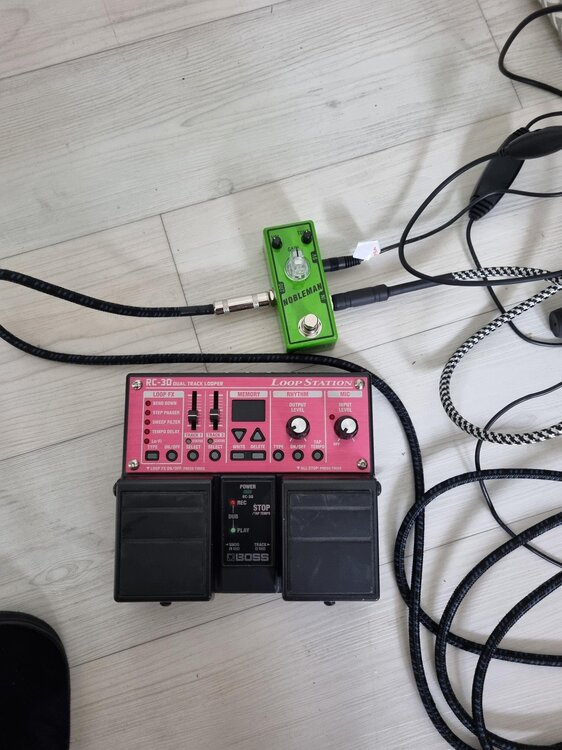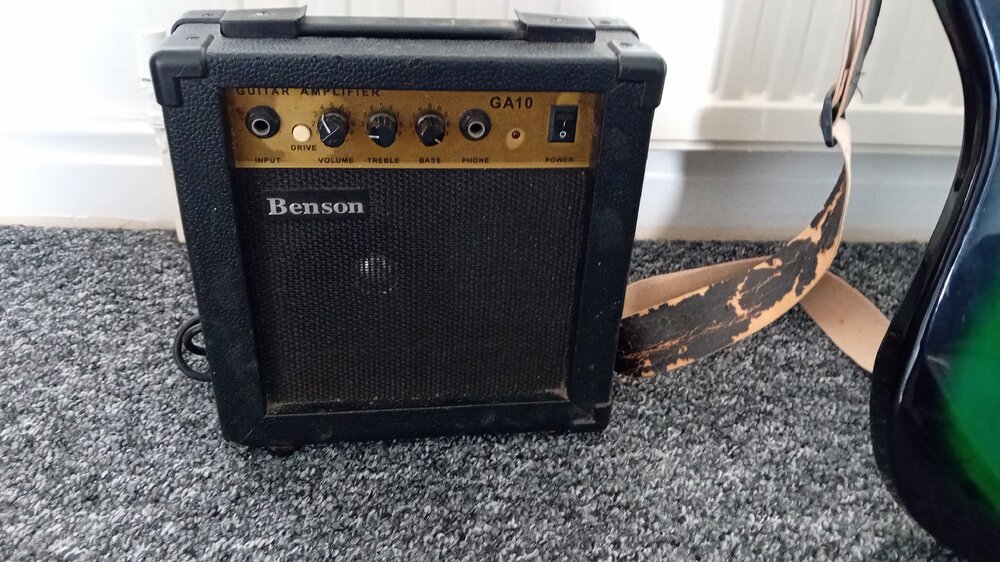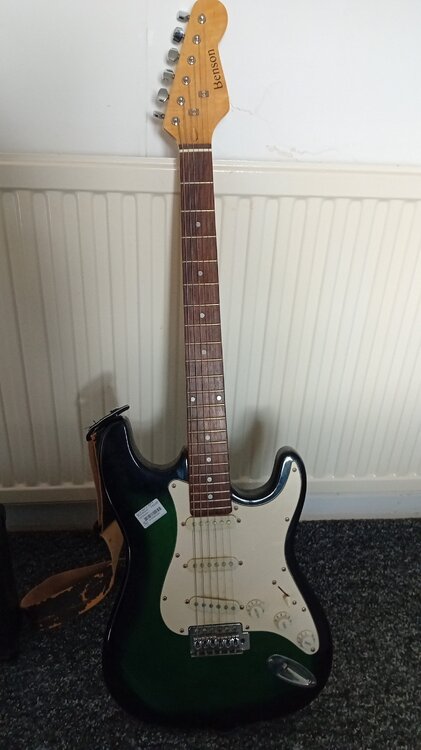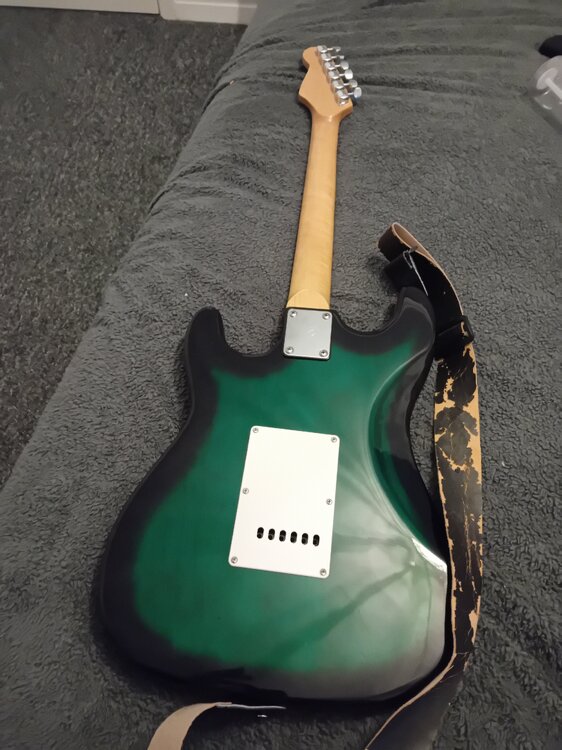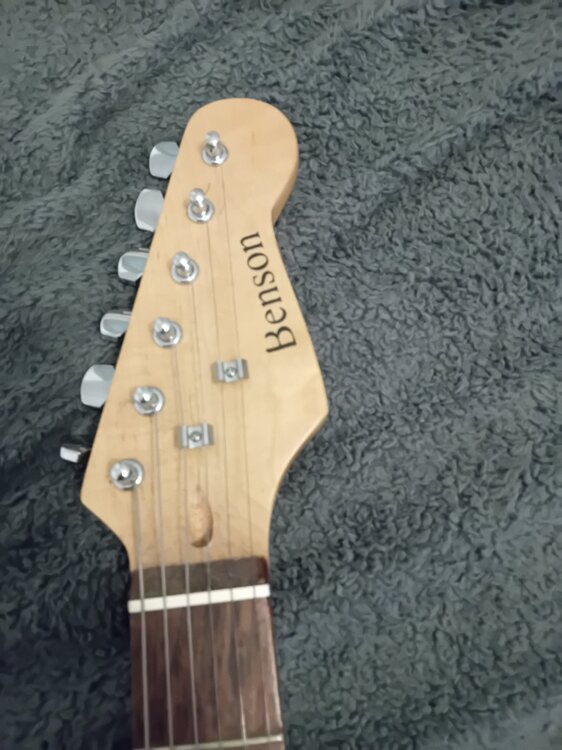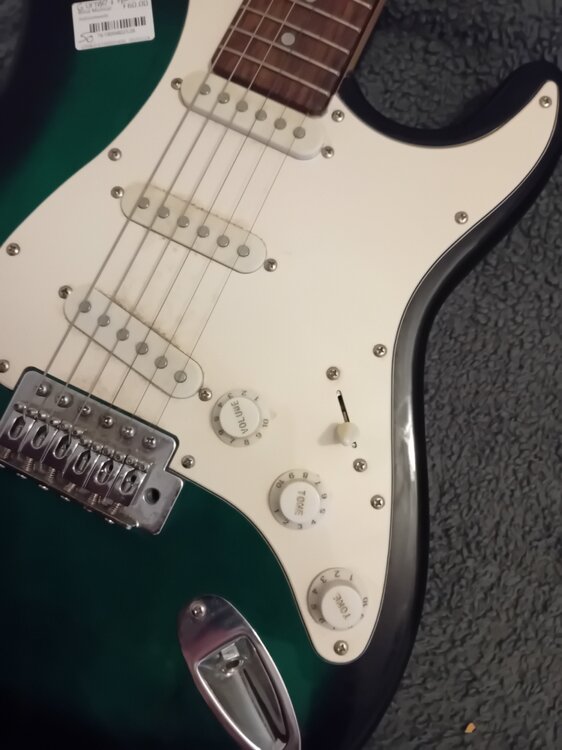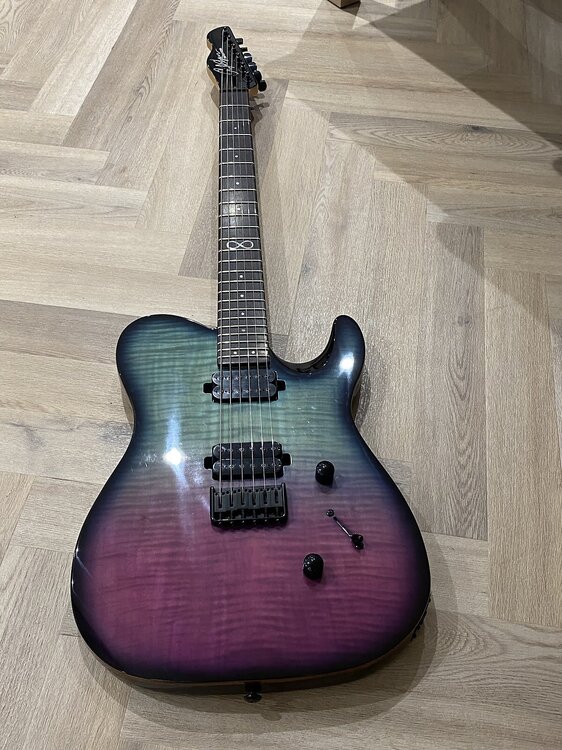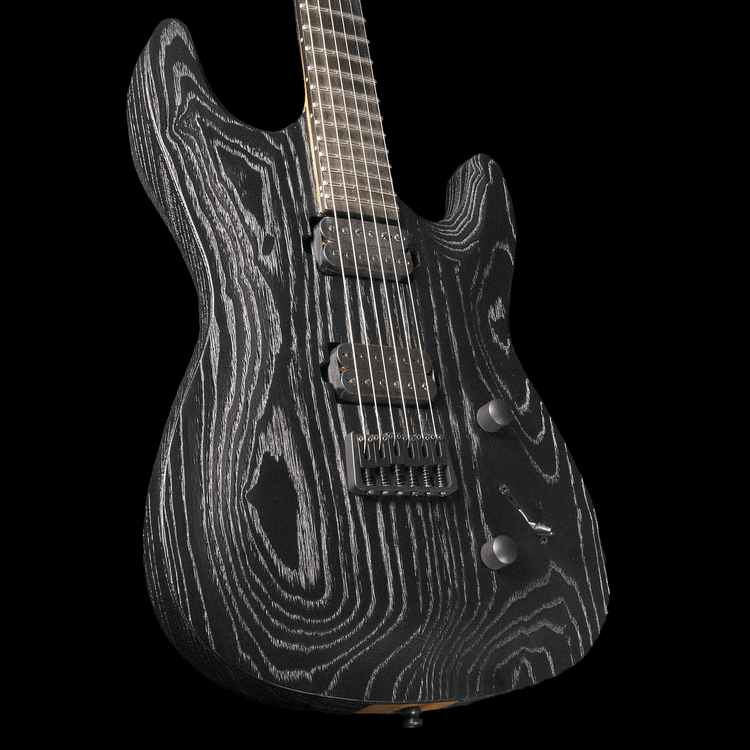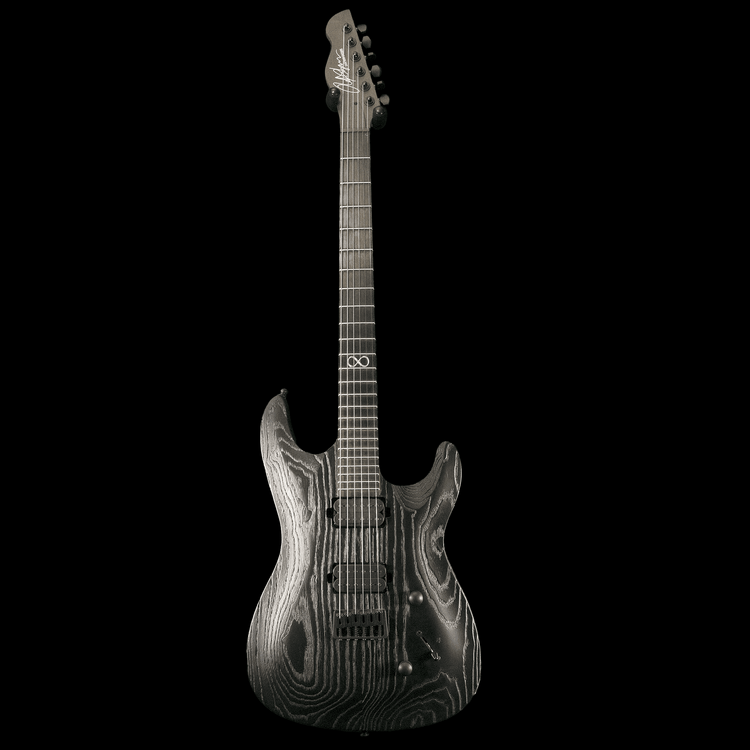All Activity
- Earlier
-
murphybridget started following Advice on guitars
-
I agree, those are possibly production model guitars and not custom made ones.
-
Strumbarmy started following Benson Guitar
-
They make a good basis for upgrading. I bought a better (push in) tremelo bridge, locking tuners and roller guides for the strings. I stripped all the plastics and hardware off, then rebuilt from scratch. The action was far too high when I got it as it had never been set up properly. Everything (and I mean everything) had to be cleaned (inside was still full of factory dust) adjusted and set up. I now have a very playable guitar, which has been seen and played by experienced band players, giving great feedback (verbal, not electronic! ) If you do decide to do upgrades, use a good quality metal ruler to take measurements accurately. There are varying neck and bridge measurements/string spacings to think about. I had to make the holes for the tuners larger to take the better quality ones. I also resoldered all the electrical connections (replaced some too) as some were almost dropping off.
-
AdamM joined the community
-
Hi Guys Here are some cool easy arpeggios for you to play! https://www.instagram.com/reel/C3qwvDeKXf8/?igsh=MWJmYXd3cmIxZzR1Yw== If you are interested in TABS just DM me (here or on Instagram) I couldn t upload them here for some strange reasons If you are interested in more stuff like this, click the follow button, im gonna do much more!
-
Rimster joined the community
-
Guitar Bomb joined the community
-
Bedroom tube amp that can take pedals?!
murphybridget replied to SilverDLine's topic in Amps and Cabs
I don't expect 5W to be plenty, in fact I think it is best suited as a bedroom amp. -
The Pinky started following And now I have bought my first pedal
-
It's getting a little bit serious now as I have bought my first pedal, a Tone City Nobleman overdrive pedal, at £35 I feel its a great little buy. It is just what I want giving the sound a little bit of an edge. The only issue is that I forgot that it needs power, fortunately I have been able to use the 9v psu for the RC30 looper that i obtained from my son. I understand that it is possible to run two pieces of kit from one psu, am i correct in this understanding? If so what do i need to do this? I haven't really used the looper much and need to work out how to use it properly, and my intention is to play a backing track to then be able to play over the top. I assume I can use the overdrive pedal with this and I assume the best way to wire the overdrive pedal in is between the guitar and looper rather than the looper and amp, as if between looper and amp then both the looped played tracks would be affected by the pedal, whereas the other waywould enable one or the other or both to be played in overdrive? Finally any tips for how to use the various controls etc on guitar and amp as i dont feel that i am getting maximum benefit and i doingthi gs verymuch by trial and error. Any thoughts or observations please?
-
Rosie C changed their profile photo
-
So the flight case needs to be protected by being in a flight case, which will need protection by being in a flight case, which will need protection by ... Zzzzzzz ...
-
Flightcase for amp and other stuff.
SecondSonUK replied to SecondSonUK's topic in Accessories and Misc
That looks great! My only concern would be damages to the box during transit. I was considering a mixer case for the head and rack bits. Looks like it'll be a big industrial rack mounting unit that i'll need to alter. -
Box carpentry is not that hard. Have you a buddy or brother-in-law that could help..? Wood cut by the local DIY shop... I modelled it first... Here is the top half, perched on our Ampeg ... Worth thinking about..?
-
SecondSonUK started following Flightcase for amp and other stuff.
-
Hi all, been a while. I've recently built a rig consisting of a peavey classic 30 head, cabinet, the breakout box of my g-system and the pedals attached to it. I'm looking for some kind of protective case/s for it to live in. Ideally I'd like to get both head and cab in a front and rear opening case with rack mounting. Stacked the head and cab measure 43x20x12in plus the 2u rack bit of the floorboard. Anyone know of something suitable or has a better idea? Thanks in advance
-
sundayguitar started following Bedroom tube amp that can take pedals?!
-
Bedroom tube amp that can take pedals?!
sundayguitar replied to SilverDLine's topic in Amps and Cabs
I've had the Blackstar 1W and 5W. Even the 5W was relatively quiet. You don't cover drums with that. But it's a great bedroom amp! -
PantanoHD joined the community
-
Matthew Longworth started following Help finding my guitar's roots
-
Hardly worthless when I only want to know about the people who made it. You have enough information. Like the other guy who replied... Absolutely amazing information, exactly the information I wanted so thank you very much for your help
-
As far as I'm aware that would have been made by the small backroom guitar maker, Gordon Parkinson. He made copies of Strats, Teles, Les Pauls, SGs and some bass guitars. As far as I'm aware they were fairly decent guitars, but sometimes a bit quirky in places, occasionally somewhat dubious finishes. Link to a facebook group about them: https://www.facebook.com/groups/622070049719625
-
Matthew Longworth joined the community
-
Hello all I could really use some help identifying the roots of my guitar. My brother has a friend who works at the local refuse centre and one day brought home a guitar which now belongs to me but I cannot for the life in me find any information on this guitar. On the headstock it says "Parkinson Leigh, Lancs"... ANY information on this guitar or the people who made it would be greatly appreciated. Thanks in advance Matthew
-
That seems to be a good choice for a mid-level player.
-
That's a fairly typical budget copy of a Fender Stratocaster. Benson guitars were often on Amazon and sold in the UK, usually in 'starter sets' which included an amp, guitar strap, guitar bag, cable, picks etc. They were invariably made in China in factories which tended to make a lot of copy guitars which were somewhat randomly branded with various names and logos on the headstock, but those factories also make a lot of outsourced fancier brands with the same cutting machines, so it will be as well made as more expensive guitars in terms of the neck and body cutting and shaping. Cheap guitars these days are pretty well made. The guitars themselves are of the kind of quality where they would cost between about 65 to 100 quid if sold alone, and the amp maybe around 40 quid or so. As noted, these days such guitars are made using CNC (computer numerical control) cutting machines, so they are well shaped and finished, with the neck being a good fit in the body's neck pocket. The wood such guitars are made from varies although the neck is certainly maple, the body is probably basswood and the fretboard could be any number of different woods such as poplar or purple heart, which is often dyed to look like rosewood. Older cheap guitars (made before 2018) did tend to have rosewood fretboards, but the CITES treaty now controls the export of endangered plant species, so more recently-made Chinese guitars tend not to have a rosewood fretboard, but in any case the wood it will be made from is probably fine for an inexpensive guitar and so this doesn't matter much. What all this means is that the basic 'bones' of the guitar is more or less as good as a Fender guitar of which it is a copy and in fact some Fender guitars, under their budget Squier brand, might even have been made in the very same factory where your guitar was made. Where budget guitars usually differ from more expensive guitars, is the hardware and the electrics, which you can upgrade with better stuff if you like, but for a beginner guitar to learn on or jam along with, it is okay for the job. The tuners will be cheap die-cast ones with probably something like a 10-1 turn ratio (how many times you have to turn the tuning peg button to have the string post make one rotation), which means they won't be very good at super-precise tuning (more expensive tuning pegs will have an 18-1 ratio). Cheap tuning pegs also tend to be made with pretty loose tolerances too, which does not help with very accurate tuning, but for 'messing about' they will probably suffice well enough. The nut is probably just run of the mill white plastic and this is okay, you can get better ones but it will do the job. The three pickups will almost certainly be cheaply-made ones with inexpensive magnets and probably a brass baseplate, but again, they will do the job although they won't sound as good as more expensive ones. Similarly, the wiring, selector switch, volume and tone pots and the jack socket will all be cheap and cheerful and again will do the job but won't be especially good quality. The same is true for the floating bridge/vibrato, which will be cheap cast metal rather than having been milled. Again, it will work, but won't be as sophisticated as a more expensive component. It's worth noting too that whether made in China, Indonesia, Korea, the US, or Europe, beyond cheaper hardware and electrical components being what makes a guitar cheap to manufacture and sell, what also reduces the cost, is the time spent doing finishing and setting up after it is made, because time is money. Cheap guitars tend to get made and given a very quick once over, and then they are packed up and sent out. Thus it's likely that, unless the previous owner spent time setting the thing up and doing things such as polishing the frets etc, it would benefit from having these things done to it. So... All of the cheap component parts can be replaced with better ones, and doing a decent set up on the guitar is not too hard either, and if you are prepared to do that, it could be made into a much better guitar (it would probably cost you a bit less than a hundred quid or so to get all the bits for that and if you spent an hour or two setting it up nicely, that would improve matters a lot), which would mean you'd have a guitar for a total outlay of around 150 quid, plus a bit of your time (not forgetting you got amp too) would be good enough for playing small gigs and recording with, and which would be as good as a guitar in around the 400 quid price bracket providing you did those tweaks. The good news for you is that the Fender Stratocaster is probably the most copied guitar in the world and so there are a ton of after-market spares and bits for them, most of which would fit your guitar, with no modifications since it is a copy with probably the exact same dimensions as a Fender Stratocaster. The means you can find decent bits for Stratocaster copies for not a lot of money. Setting up a guitar is not very hard to do, there are a ton of videos on youtube about how to do that, although you would need a few specific tools to do it well, but these are not hugely expensive to get hold of. The amp is a cheap generic transistor amp which is okay for practicing on, but it won't sound especially great. Then again, if you are just learning and noodling around with the guitar, it will do the job. As far as sounds go, even fairly cheap guitar pickups can sound good through a good amp so the ones on it are okay enough, but conversely, very good pickups will not sound great through a cheap amplifier, so a cheap amp is often the weak link in an electric guitar set up. Having said all that, for 45 quid you did well to get all that you got. It could easily have gone for about 80-100 quid for the guitar and amp if it was on Ebay or Reverb, so it was a bit of a bargain really. Just don't play it standing up with that guitar strap; it looks cheap and nasty and I would not trust it; if it lets go, your guitar will hit the ground hard and that won't do it any favours. Oh, and don't make a habit of propping it up against a radiator. I know you probably did that just to take the picture, but it can cause two things; if the radiator is on, it will heat the guitar neck up and things will expand and mess up the set up of the truss rod, and the square metal edge of the radiator can put dings in the back of the neck, which would be a shame because it looks in pretty good nick. One last thing: You might be unaware that this guitar would have originally had a 'tremelo arm' which could be fitted onto it. Strictly speaking, even though people call these 'tremelo arms', they are more correctly called vibrato arms. They screw into the threaded hole on the lower part of the bridge so you can use this to tilt the bridge back and forth and make the sound waver in pitch. The adjustable springs which counteract that action are accessed under the white plate on the back of the guitar. You can find them on Ebay, Temu, Ali Express etc, be aware however, that there are a couple of different thread sizes for these things, most cheap copies use a 5mm thread, but not all of them. It would look like this if you fitted one, although I think a chrome one would look better than the black one in this picture:
-
Hello I just bought this guitar and amp from a 2nd hand shop for £45 the pair. I just wandered if anyone knows the model of Benson guitar please. Someone told me it was a Fender replica.
-
dan1382 joined the community
-
Ferlendis joined the community
-
Hi, I’m thinking about buying a small head and cab-combo. So far I’m leaning towards the Marshall DSL1 hr with the matching 1x12 cab or the Harley Benton 15 tube head with a 1x12 HB Greenback. My impressions when reading/watching YouTube is that the Marshall is a great little amp (I actually don’t need more than 1 watt), but the cab is not so good. And finding a good alternative cab is hard since it is a 16 ohm amp. Haven’t been able to find anything bad about the Harley Benton, but it is “only” a HB and not a Marshall… If anyone have tried these amps/cabs or have any input to give, I would be very grateful! All the best, Per
-
They look great. (What would KDH say, though? )
-
2 NGDs in the space of a week, good work! Love the paint job on the T type.
-
Spotted a Chapman ML3 modern on facebook marketplace at a good price last weekend so pulled the trigger and absolutely loved it. So much so I bought an ML1 Pro this weekend ( I really do need a bigger house !) This is one of the best looking and playing guitars I've owned (it's so bassy !)even when compared to custom build territory like my Ambler. Now I need the green sparkly semi - hollow one and a baritone to complete the collection !
-
Even though it looks and feel a bit whacked, that posture sure made it a lot easier to fret the frets, though I found it very hard to accurately fret. Probably just practice, but I'll throw that one in for a change. Aah, also made it a lot easier to fret. I'm doing it that way for this particular song since that's what he's doing and it was the only way for me to play the E string together with the other notes. I'm not sure how he does it on the recording and everytime I see him live he seem to be playing differently. I think it's supposed to be a muted tone too but that's far over my league at the moment. But with practice comes experience, so It seems I need to practice a lot more and for the hand easier riffs to build up the core strength. That tip was especially useful when playing Poison since that far stretch in the intro was a whole lot easier doing with the thumb in the center back! I'm not entirely sure what you mean, you mean while playing the same string(s) on different frets? That's something I've been practicing but wow, it's pretty hard. Though that along with the tips from Plucking the strings economically sounds like something I should embrace and practice more. I can up pick one single string, like when playing temple of the king. But if it's two or more, I have to use a very thin pick to even somewhat succeed and I find them hard to get a good sound out of. I'm not a fan of shedding or fast play myself, I like it clean. Ritchie tends to keep it so with good rythms, like the pre-intro when he plays man on the silver mountain live in munich, I like that kinda play. I found out, by accident that for me, resting the palm on the bridge is the easiest way for me to play good sounding muted notes as I can't do that with the fretting hand yet. Though it feels as if the hand is so far back there that it's hard to pick the strings accurately, so I haven't really practiced plucking them there. Usually when something hard we tend to go easiest route and not really bother. But you make me realize that it's all just practice and it'll get better over time. I think you're absolutely right! A very good observation!! I just measured the lowest part of the low E down to the 12th fret and it measures 3mm, I think that could be chopped down a good 1mm. Maybe even more, I'll have to bring it to the shop. I think you have a very very good point here, might be due to the high action. But I'll keep that one in mind when playing! Also, I just played and I slowed it down quite a bit. I noticed I had a lot more control over my fretting hand, the fingers wasn't moving anywhere near as much as in the video nor as far away from the neck. Interesting, maybe I should take it a bit slower, though a hard thing to do when the mind and body never wants the same heh. But to be realistic, I don't think I have the accuracy to play well yet, I think it's all just muscle memory from my side, my hand knows where to move. Which is not the way to go, so slower it is. Thank you very much guys, very exhaustive and detailed answers!
-
Harley Benton ST 62 + Fender CS FAT 50's pre-wired
murphybridget replied to FrankAtari's topic in Gear Porn
I'll do when I have the chance. -
Thanks for the detailed responses. The neck o the Tele copy I have does feel a bit cramped (not enchche by the poor fretwork but then it was £79! I was thinking Single cut Epiphone or maybe PRS SE. Or if the Sire guitars are as good as the basses ?
-
Possibly squeezing too hard, relax a little and don't overdo it. Little and often is better than big sessions. I see that you're using your thumb for the E string in the video and this may be a contributing factor to your discomfort. Whilst there is a place for using your thumb for big stretches and wide chord voicing, it's not normally a good habit to start with. I'd use my index finger for that note, in this instance. That'll come with practise, try slowing things down to start with.

